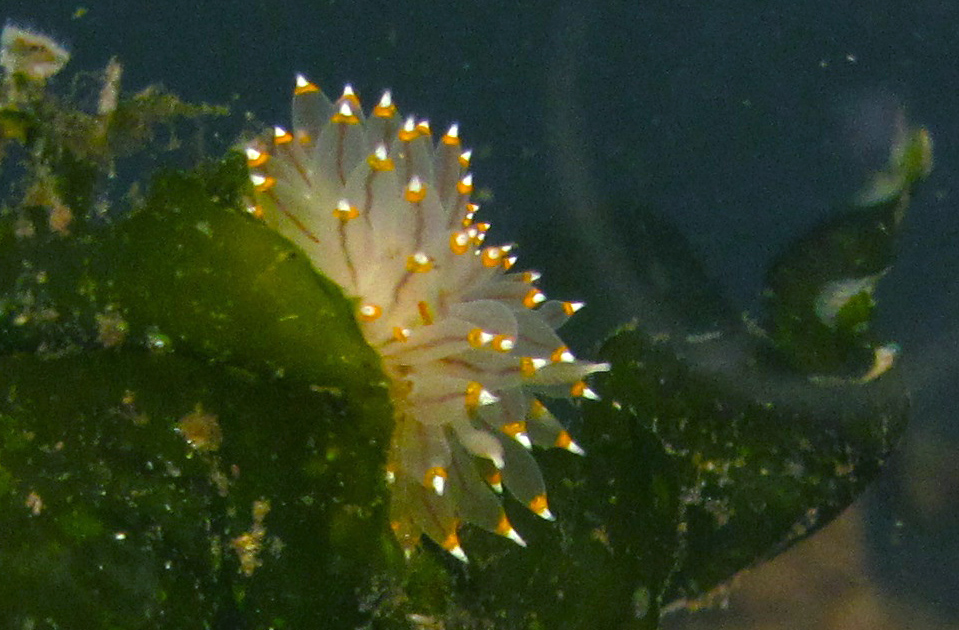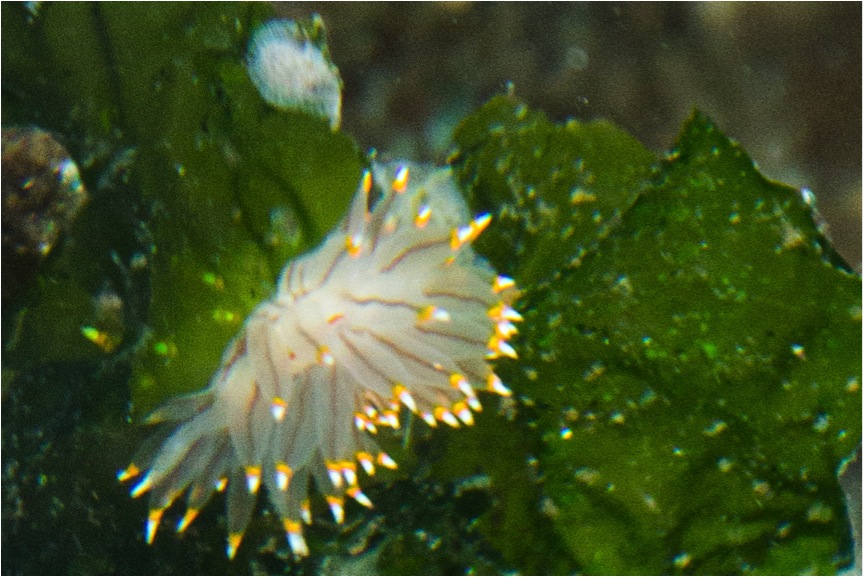White-and-orange-tipped nudibranch • Janolus fuscus
Identification
This small (to 2.5 cm) whitish nudibranch can be identified by its many large cerata tipped with orange and white. The cerata, which have brown inner cores, project from all over the dorsal surface of the animal including in front of the rhinophores. There is a thin red stripe between the two rhinophores.
Habitat & Range
The white-and-orange-tipped nudibranch inhabits the intertidal and subtidal to a depth of 30 m. Its eastern Pacific range extends from southern Alaska to southern California; it is also found in the Sea of Japan.
Similar Species
The presence of cerata in front of the rhinophores helps to distinguish this species from the otherwise similar opalescent nudibranch (Hermissenda crassicornis).
Intriguing Info
This species preys on bryozoans. It often hosts an endoparasitic copepod, Ismaila belciki. A study in Oregon found the rate of infection could be as high as 80%.
iNaturalist
https://www.inaturalist.org/taxa/47460-Janolus-fuscus
This small (to 2.5 cm) whitish nudibranch can be identified by its many large cerata tipped with orange and white. The cerata, which have brown inner cores, project from all over the dorsal surface of the animal including in front of the rhinophores. There is a thin red stripe between the two rhinophores.
Habitat & Range
The white-and-orange-tipped nudibranch inhabits the intertidal and subtidal to a depth of 30 m. Its eastern Pacific range extends from southern Alaska to southern California; it is also found in the Sea of Japan.
Similar Species
The presence of cerata in front of the rhinophores helps to distinguish this species from the otherwise similar opalescent nudibranch (Hermissenda crassicornis).
Intriguing Info
This species preys on bryozoans. It often hosts an endoparasitic copepod, Ismaila belciki. A study in Oregon found the rate of infection could be as high as 80%.
iNaturalist
https://www.inaturalist.org/taxa/47460-Janolus-fuscus
References
Goddard, J. H. R. (2003). Janolus fuscus O'Donoghue, 1924. In Sea Slug Forum. Australian Museum, Sydney. Accessed 27/01/2014.
Lamb, A., and Hanby, B. (2005). Marine Life of the Pacific Northwest [electronic version]. Madeira Park, BC: Harbour Publishing.
Wolf, M. And Young, C. M. (2014). Impacts of an endoparasitic copepod, Ismaila belciki, on the reproduction, growth and survivorship of its nudibranch host, Janolus fuscus. International Journal for Parasitology. 44(6):391-401
Authors and editors of page
Kelly Fretwell and Brian Starzomski (2015).
Goddard, J. H. R. (2003). Janolus fuscus O'Donoghue, 1924. In Sea Slug Forum. Australian Museum, Sydney. Accessed 27/01/2014.
Lamb, A., and Hanby, B. (2005). Marine Life of the Pacific Northwest [electronic version]. Madeira Park, BC: Harbour Publishing.
Wolf, M. And Young, C. M. (2014). Impacts of an endoparasitic copepod, Ismaila belciki, on the reproduction, growth and survivorship of its nudibranch host, Janolus fuscus. International Journal for Parasitology. 44(6):391-401
Authors and editors of page
Kelly Fretwell and Brian Starzomski (2015).






